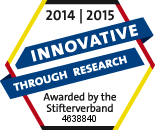 Nowadays, many services are based on wireless networks, where the service provider is not owner or operator of the mobile network. The most popular examples are Virtual Network Enablers and Operators. They offer very attractive subscription models for usage in specific foreign countries and other value added services. Their testing process is typically very difficult, because they need to verify their services in various networks. It gets really tedious, when the tests have to involve international roaming from one country to another. Exactly for these purposes, Qosmotec has invented the Network in a Box – a combination of a freely configurable mobile network (consisting of core and radio network part) and a handover emulator.
Nowadays, many services are based on wireless networks, where the service provider is not owner or operator of the mobile network. The most popular examples are Virtual Network Enablers and Operators. They offer very attractive subscription models for usage in specific foreign countries and other value added services. Their testing process is typically very difficult, because they need to verify their services in various networks. It gets really tedious, when the tests have to involve international roaming from one country to another. Exactly for these purposes, Qosmotec has invented the Network in a Box – a combination of a freely configurable mobile network (consisting of core and radio network part) and a handover emulator.
Freely configurable radio part
The radio part of the mobile network emulator consists of signal generators specifically for GSM 900/1800, UMTS Band I and LTE Band 7 (2600 MHz). Each signal generator can be configured with all relevant cell parameters like Mobile Country Code (MCC), Mobile Network Code (MNC), Location Area Code (LAC), Cell Id and Frequency (ARFCN) and then creates a correctly modulated signal that is detected by any mobile phone. “With two, three or four cells, you can simulate the local situation in any country, emulating various network operators or in a border region, emulating networks in different countries”, explains Qosmotec’s Managing Director Dr. Dieter Kreuer, who has developed the concept of configurable mobile network for test laboratories. Configuration time for switching a cell to a completely new configuration is 15 – 20 seconds. “Most probably the quickest way to get a bit of vacation feeling, when you see the name of a caribean mobile network operator on your phone”, says Dr. Kreuer with a smile on his face.

The Home Location Register (HLR)
Your mobile phone recognizes the emulated cell in the network search. To be able to register to the emulated network, the SIM card must be added to the Home Location Register (HLR) that belongs to the emulated core part. During network search, the phone sends its IMSI number which can be added to the HLR. Thus, an administrator can maintain the test network and make sure, that no uncontrolled registrations occur.
Test with all functions and services of a public mobile network
Once registered, the mobile phone can use all services of a normal mobile network. Above all, testers can influence on the mobile network behavior and therefore act like a real mobile network operator. He can establish network generated calls, can let the mobile network send SMS messages or influence the quality of a data transmission by setting packet delays or packet losses separately on the uplink and on the downlink. And he can freely configure USSD services – from simple subscriber requests up to complex interactions between subscriber and operator. “For virtual network operators, this is the most important test functionality, because most of their value added services on SIM cards are based on textual communication with the network”, says Dr. Kreuer.
Handover emulation and mobility simulation enable international roaming tests

The QPER software displays in which cell a mobile device is registered and which services are in use
The combination with Qosmotec’s field strength emulator QPER, that emulates the subscriber’s mobility in the wireless network, makes the network emulator now a real mobile network in a box.. The neighborhood of cells can be set as a part of the cell configuration,. Dr. Kreuer knows, what this is good for: “If two cells are linked together as neighbours, a handover between them is possible, while otherwise the network connection would be completely interrupted, when the mobile changes the cell”. With this capability, the emulated cells can supply input for a handover matrix consisting of digitally controllable attenuators, and the mobile phones on the other side of the matrix can see several cells with user controllable strength and move between cells or roam between countries.

The schematic setup for the emulated network: the radio part is available for all technologies from 2G to 4G
The control of the complete emulated mobile network is smoothly integrated into the QPER virtual drive test software. Having preconfigured the cell parameters, they are set on the signal generators by simple drag & drop actions and it is clearly visible, when they are activated. Users can see, which mobiles attempt to register to the network, when they have been successful and what type of link they have (circuit switched or packet switched; GPRS, EDGE, 3G HSPA or LTE data transmission).
Having such a flexibly configurable mobile network in your lab always makes sense, when testing interoperability of services that have to work in other countries. Typical application cases are
- Multi-IMSI applications, where a mobile shall follow a dedicated price plan in foreign countries, that is identified by the used IMSI number,
- Toll Collection, that has to begin and end at the country’s border
- Intelligent Transport Services applications that go via 3G and 4G, where the driver shall be able to rely on internationally.
 Qosmotec showcases its Car-2-X test system at the 2015 ITS World Congress in Bordeaux, France. Between October 5th-9th 2015 Qosmotec will demonstrate that it is not necessary to be a radio expert for running a channel emulation.
Qosmotec showcases its Car-2-X test system at the 2015 ITS World Congress in Bordeaux, France. Between October 5th-9th 2015 Qosmotec will demonstrate that it is not necessary to be a radio expert for running a channel emulation.













